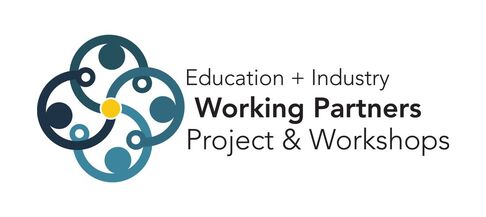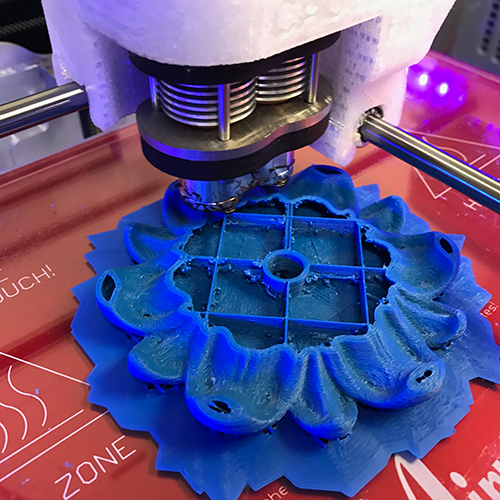|
The Facility
ATE Center - National Resource Center for Materials Technology Education (MatEdU)
Edmonds College, WA
Key Outcomes
- Provides industry and community access to existing instructional space and equipment during non-instructional hours
- Leveraged existing industry relationships to encourage use of facilities
- Partnered with other entrepreneur support organizations to provide innovators with guidance from design to marketing
- Developed intellectual property policies to ensure users retain all IP rights
- Established procedures and processes for safe, efficient community use of equipment
- Developed fee structure to accommodate range of use from full facility rental to drop-in to assisted design
- Worked with Veterans agencies to develop supports and access to returning veterans
Summary

Co-located on the campus of Edmonds College with – and supported by – the National Center for Materials Technology Education (MatEdU), The Facility consists of labs and classrooms used by Edmonds' academic program by day and by industry partners and innovators to test, train, create, engage, and collaborate during the time when the labs and equipment are not in use. As noted on its website, The Facility Makerspace is "an 11,000 square foot innovation sandbox with the tools, training, and community you need to turn your thoughts into things."
|
The first industry contract for what would eventually become "The Facility" was with The Boeing Company, who signed a five year agreement to host international training workshops for technicians charged with maintaining and repairing planes globally. The agreement worked well for both parties; the workshops were scheduled around the academic calendar and program use and Boeing secured space and access to the equipment they needed without having to navigate the stringent security requirements for international use of their own facilities. Boeing also installed and donated additional equipment that remains in place and has become a more dedicated internship partner for the academic program. PI Mel Cossette attributes Boeing's increased internship interest in "knowing what's here, what the students are working with, and that the students are getting the skills that Boeing needs".
|
""Some of our other industry partners have come in, seen what we are doing, seen how they could link up to some of the equipment we have, and then they start doing workshops here too." Mel Cossette, PI |
|
MatEdU utilized its industry network to identify other businesses, small and large, for use of The Facility for training and prototyping; some of these agreements similarly resulted in donated supplies and services. But as the long-term agreement with Boeing approached its conclusion, the team also began to research recruiting users from the local community and regional non-profits; they worked with two of the state's Senators to identify opportunities with groups supporting returning veterans, for example, and other service organizations.
|
One critical early partnership the team used to reach out to prospective independent user of The Facility was with the Northwest Innovation Resource Center (NWIRC), a non-profit with a large user base that helps entrepreneurs and inventors develop business strategies. The two groups co-hosted an initial "innovator's workshop" on a Saturday to gauge interest, inviting innovators to come share what they were doing and discuss needs. The turnout was more than twice what was expected, with PI Mel Cossette recalling that the lively session gave the organizers the indication that "the community was hungry for this type of information and this type of access."
|
This workshop began a phase of building community and attracting users; in fact, one of the experienced innovators at that initial meeting became the first contract employee of The Facility, hired to assist with the governmental and college paperwork, and bringing along his knowledge and experience with makerspaces to develop policy and procedures. As usage began to grow and the need for consistent facility and user support became evident, a permanent position was posted; the contract worker – who also provides design support - was the successful candidate for the job. |
|
"You can come to Edmonds Community College to take a class, take a certificate, increase your knowledge, get a degree, and prepare for a job. But The Facility allows you to also come to Edmonds Community College with an idea, and that idea may create your own job. It also allows local industry to make use of our space and advanced equipment" --Mel Cossette, PI |
Innovators and inventors are, of course, primarily drawn to The Facility in order to access specialized and advanced equipment; MatEdU's industry partners have been generous in their donations of supplies and in servicing equipment. Others are attracted due to the fact that all intellectual property rights are retained by the user. This is appealing especially to workers of some of the region's largest employers who may offer similar facilities for employees to advance their ideas but at a cost: the company retains a percentage of the IP rights of anything developed on-site. Others are drawn to The Facility as a community space and a place to meet like-minded people; programming continues to be developed and offered that serves to connect users and the general community. In addition, The Facility continues to develop partnerships with community groups to foster pathways for veterans, underrepresented populations and others. The fee structures and administration of The Facility continues to evolve as the staff dialogue with the user base - industry partners as well as individual entrepreneurs and inventors - and regional awareness of the opportunities continues to expand. |
Impacts
- Provides access for industry and community
The Facility provides access to advanced tools and equipment to industry partners who often use the spaces for training, and to the entire innovator community. - Expanded student learning opportunities
Employers have an increased interest in obtaining interns from the academic program after using the space. In addition, students benefit from working alongside innovators in the labs.
- Increased equipment use and maintenance
Early notice of technological developments and workplace change is provided by industry, allowing programs to more accurately anticipate future workforce needs and preemptively revise curricula.
|
"We get students who want to help an innovator do something. Those students are now learning about ethics, and proprietary information, and intellectual properties, everything really." Mel Cossette, PI |
- Increased academic and non-profit collaboration
The availability of The Facility's equipment, space and staff have increased the number of partnerships with higher educational institutions outside the region as well as regional service organizations.
Challenges
- Overcoming faculty concerns regarding open access
Faculty did not readily take to the idea of opening academic labs and classrooms for industry or public use. This resistance declined as the benefits to the program and students – such as new equipment – became evident. .
|
- Developing procedures and processes for safety and accessibility
Ensuring that users were vetted in safety protocols and procedures prior to granting access was a clear priority. Staff reviewed safety modules in related academic courses and the safety clearance procedures of other open use facilities and developed training materials and testing procedures to verify safe and proper use of the space and equipment. - Securing resources for staffing
Staffing was required in order to provide consistent user support, scheduling procedures, and overall concerning facility management. Securing resources for staffing required innovative planning and collaborations both internal and external. - Determining appropriate fee structures
Several revisions of rental fees have been necessary as data is collected and analyzed regarding costs and usage patterns.
Implementation Strategies
|
"Everybody is keen on 3D printing but sometimes 3D is not the answer for their project. And so we say, "How about we check out the CNC or let's check out the laser cutter -- this is the good, the bad, the ugly of all three of them. Are you familiar with any of these?" And they might say, "No, I've only heard about 3D. Tell me more." Mel Cossette, PI |
- Befriend the marketing department
Keep your college's marketing department informed about industry usage, prototypes that are successfully developed in the space, and about visits by industry leads or politicians. This helps build awareness on and off campus and increases advocacy and visibility. - Gain a solid understanding of state and institutional requirements, policy
Each state has different regulations concerning the use of state resources, including the use of facilities and equipment at state-funded colleges; the colleges themselves also may have operating rules to be followed. Gaining a solid understanding of these regulations is fundamental to launching, running and expanding community use of an educational facility.
- Collaborate regionally and nationally
Working with industry partners and regional innovation networks provides access to potential users while partnering with non-profits can create projects to serve underrepresented populations, and all collaborations can build goodwill and awareness of the college and space. Providing testing and services to other educational institutions has also provided funding for staff and opportunities for students.
Additional Resources
Subject Information
|




